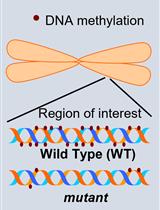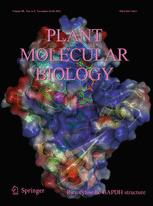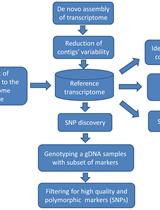- EN - English
- CN - 中文
High Resolution Detection of Genetic Changes Associated with Transposons
高通量鉴定转座子及其侧翼序列-转座子展示联合454焦磷酸高通量测序法
发布: 2013年06月05日第3卷第11期 DOI: 10.21769/BioProtoc.788 浏览次数: 10370
评审: Tie Liu

相关实验方案

利用Southern杂交技术研究植物中转座子DNA甲基化和拷贝数变异的情况
Vivek Hari Sundar G. and P. V. Shivaprasad
2022年06月05日 3332 阅读
Abstract
Transposable elements (TEs) are repetitive sequences, capable of inducing genetic mutations through their transpositional activity, or by non-homologous or illegitimate recombination. Because of their similarity and often high copy numbers, examining the effects of mutations caused by TEs in different samples (tissues, individuals, species, etc.) can be difficult. Thus, high throughput methods have been developed for genotyping TEs in un-sequenced genomes. A common method is termed Transposon Display (or transposon SSAP), which utilizes restriction enzymes and PCR amplification to produce chimeric DNA molecules that include genomic and TE DNA. The advent of second generation sequencing technologies, such as 454-pyrosequencing, have dramatically improved the resolution of this assay, allowing the simultaneous sequencing of all PCR products, representing all amplified TE sites in a specific genome.
Keywords: Transposon (转座子)Materials and Reagents
- Two oligonucleotides which form the double-stranded adapter, with an overhang complementary to the overhand of the restriction enzyme used. In the case of Mse I, the overhang is a 5' TA, and the adapter sequences are 5'- TACTCAGGACTCAT-3' and 5'- GACGATGAGTCCTGAG-3'. The two nucleotides at the 5' end of the former oligonucleotide will constitute the 5' TA overhang, after hybridization of the two sequences (green rectangles in Figure 1). These oligonucleotides should be designed such that they do not resemble know sequences in the examined species.
- Pre-selective primers, one complementary to the adapter with the addition of a C nucleotide at the 3' end (5'-GATGAGTCCTGAGTAAC-3'; primer P2 in Figure 1), and the other complementary to the TE of interest (primer P1 in Figure 1). The TE-specific primer should be designed as a reverse-complement of the 5' end of the TE with a Tm=60 °C, between 30-50 bp into the TE (to allow for sequence validation in downstream assays). Restriction enzyme recognition sites (TTAA) between the primer and the 5' end of the TE should be avoided. Both the adapter- and TE-specific primers should be designed with the linker A and B sequences (for 454-pyrosequencing) at their 5' ends.
- NaCl
- T4 DNA ligase and buffer (New England Biolabs, catalog number: M0202 )
- Restriction enzyme MseI (New England Biolabs, catalog number: R0525 )
- Taq DNA polymerase and Taq DNA polymerase buffer (EURx, catalog number: E2500 )
- MgCl2
- dNTP mix

Figure 1. An overview of the TD-454 pyrosequencing method. (a) The genomic samples are fragmented with a restriction enzyme and ligated to adapters (green rectangles); (b) The fragments undergo PCR with a primer specific to the adapter (containing a 454 linker sequence) and a primer specific to the analyzed TE (containing a 454 linker sequence); (c) The resulting PCR amplicons are sequenced with a 454 pyrosequencer.
Equipment
- Thermal cycler
Procedure
文章信息
版权信息
© 2013 The Authors; exclusive licensee Bio-protocol LLC.
如何引用
Yaakov, B. and Kashkush, K. (2013). High Resolution Detection of Genetic Changes Associated with Transposons. Bio-protocol 3(11): e788. DOI: 10.21769/BioProtoc.788.
分类
系统生物学 > 基因组学 > 转座子
植物科学 > 植物分子生物学 > DNA > 基因分型
您对这篇实验方法有问题吗?
在此处发布您的问题,我们将邀请本文作者来回答。同时,我们会将您的问题发布到Bio-protocol Exchange,以便寻求社区成员的帮助。
Share
Bluesky
X
Copy link












